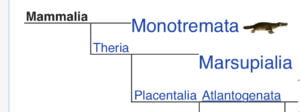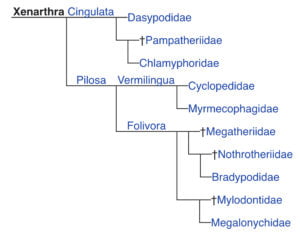The parting between Xenanthra (the sloth group) and Boteoeutheria (the monkey group) happened approximately some 100 million years ago. Before this time, all sloths would be monkeys and all monkeys would be sloths. In reality however, neither of the modern day species existed before this timeframe.
In this article, we‘ll be looking at the taxonomical classification of sloths and show you how they differ from the modern day group of monkeys. Keep reading.
Are sloths monkeys?
No. Sloths aren’t monkeys and monkeys arent sloths. The earliest group of sloths and monkeys separated some 100 million years ago. Three major clades of placental mammals exists, (the last main group where the monkey-sloth split happened). They include:
- Afrotheria
- Xenarthra
- Boteoeutheria.
Sloths are proud members of the Xenarthra clade whereas monkeys belong to the Boteoeutheria clade. Many features and characteristics exist that distinguishes members of one clade from the other and we shall be discussing them at the end of this article.
Taxonomical Classification for Sloths and monkeys
Both sloths and monkeys are placental mammals, one of the three major clades (or groups) of the mammalian class. The other two include: monotremes and marsupials.

Brief Definitions:
Taxonomical classification: a system of grouping living things based on some characteristics that they share. Groups start off broad and then taper down to become more narrow and specific, where all animals belonging to the smallest possible group are so closely related to one another that they can actually inter-breed. Broader and much earlier groups classify living things based on some ‘basic’ shared characteristic whereas the smaller and much narrower groups (embedded within each broader group) classify living things based on more specific traits and features.
Mammals: All animals that share these basic characteristics: have specialized apocrine sweat glands called mammary glands for producing milk for their offsprings (especially in females), a neocortex region of the brain responsible for sensory perception and cognition (to mention a few), molar set of teeth among their dentition, hair or furs at any life-cycle stage of their lives (which can take different forms such as quills, coats, or whiskers), single bone in their lower mandible or jaw that fixes to the skull and allows for more power and stability during chewing and grinding, and finally three bones in their middle ear region (among many other traits).
Placental mammals (placentalia): A type of mammal that grows a specialized organ called the placenta used for nourishing and protecting their young during gestation. The group got its name form this organ.
Marsupial mammals (Marsupialia): A type of mammal with a rudimentary placenta. They give birth to an underdeveloped young and nourish it in a pouch located somewhere on their bodies (usually on their ventral sides on the lower body regions) until they fully mature and learn to become independent on their own.
Monotreme mammals (monotremata): A type of mammal that give birth to their young ones by laying eggs. They nourish these young ones after birth with milk that squirts out impatiently from their underside.
The Placental Group
The placental group contains all mammals that develop placenta during birth. Under this group, three major clades also exist. They include: Afrotheria, Xenarthra, and Boteoeutheria. Both sloths and monkeys occupy different clades within this broad group. Sloths are Xenarthra mammals while monkeys are Boteoeutherian mammals.
Sloths classification (major summary)
- Placental mammals
- Xenarthra (super-order)
- Pilosa (order)
- Folivora (sub-order)

Monkey classification (major summary)
- Placental mammals(super-order)
- Primates (order)
- Haplorhini (sub-order)

Under the Xenathra group, 31 distinct species exists which are shared between three animals: anteaters, sloths and armadillos. For the Boteoeutheria, over 2000 species are identified spread across numerous extant animals: From monkeys, apes, deer, to elephants, whales and even we humans: only one specie of humans exists though.
While the break off between the different placental clades happened approximately some 100 million years ago, modern day sloths and monkeys were non-existent then. Only creatures they would eventually evolve from were present at that time. The primary ancestors of modern sloths and monkeys evolved some few million years ago from these much more archiac species.
How Xenanthras differ from the monkey group
Xenanthras are differentiated from placentals and other mammals by a variety of characteristics; these characteristics include:
- Xenanthras have extra articulations on their vertebral joints (lumbar vertebrae) which are unlike other placental mammals. As a matter of fact, the name Xenarthra itself is a concoction of two greek words. Xénos menaing strange and árthron meaning joint. So the group itself is named after this feature.
- Xenanthras have different numbers of vertebrae that other mammals. Most have either more or less of the actual amount. Sloths for example, have a reduced number of lumber vertebra than other mammals, and can have more or less the number of cervical vertebrae that most mammals.
- The ischium region of their pelvis (the waste bone) is fused to the sacrum of the spine.
- Males have an internal testicle rather than an external one.
- Xenarthras have the lowest basal metabolic rate amongst all placental mammals including monkeys. The rates are around 40 to 60 percent less the value expected for mammals their size.
- Most xenanthras have reduced dentition: that are mostly similar in nature (or are homodont), continuously growing and wearing (by action of munching on the tough fibrous tissues of tropical leaves) throughout their lifetime, and lacking enamel; the outer white tooth covering that provides strength for grinding and chewing in humans. Most of them, particularly the sloths, do not also transition from milk to permanent teeth at any stage in their lifetime. They are born with the set of natural teeth they would bear for the rest of their lives.
- Xenanthras have single color vision. They see the world in shades of grey: black and white. Like your old 1880’s self before the invention of colored television.
More Interesting articles:
- Facts about baby sloths
- Facts about sloth on the ground
- Sloth Predators: What eats sloths?
- Sloth Habitat: Where do sloths live? (with map)
Obsessed with sloths? Check out our sloth category to learn more about them:
Cite this Article ” (APA Format)
Bunu. M. (2020, June 18). Are sloths monkeys?. Retrieved from http://emborawild.com/are-sloths-monkeys/

